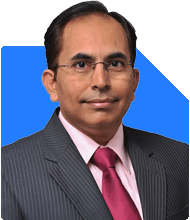Should I switch my current Mutual Fund investments?
Ramalingam Kalirajan |10893 Answers |Ask -Follow
Mutual Funds, Financial Planning Expert - Answered on Apr 03, 2025
He has an MBA in finance from the University of Madras and is a certified financial planner.
He is the director and chief financial planner at Holistic Investment, a Chennai-based firm that offers financial planning and wealth management advice.... more

I am currently investing 28000/- in following mf . Kindly suggest me whether i am investing in right MF or not. Suggest if to be switched in to which MF HDFC LARGE AND MID CAP FUND - REGULAR PLAN - GROWTH SIP Amount 5000 HDFC NIPPON INDIA SMALL CAP FUND - GROWTH PLAN - GROWTH OPTION SIP Amount 5000 HDFC LARGE CAP FUND - REGULAR PLAN - GROWTH SIP Amount 3000 HDFC FOCUSED 30 FUND - REGULAR PLAN - GROWTH SIP Amount 3000 HDFC MID-CAP OPPORTUNITIES FUND - GROWTH OPTION SIP Amount 3000 ICICI PRUDENTIAL INFRASTRUCTURE FUND - GROWTH SIP Amount 3000 HDFC FLEXIVAP FUND - GROWTH SIP Amount 4000 CONTRA FUND =4000 PLEASE REVIEW
Review of Existing Portfolio
Large Cap Exposure (Rs 3,000/month)
Large-cap funds offer stability.
The allocation here is low compared to mid and small caps.
A slight increase may help balance volatility.
Large & Mid Cap Exposure (Rs 5,000/month)
This fund gives exposure to both stable and growth-oriented stocks.
Keeping this allocation is fine.
Mid Cap Exposure (Rs 3,000/month)
Mid-cap funds can give high returns but are volatile.
Exposure is reasonable but should not be increased further.
Small Cap Exposure (Rs 5,000/month)
Small caps have high growth potential but also high risk.
Reducing this allocation slightly may help manage risk.
Focused Fund (Rs 3,000/month)
These funds hold fewer stocks, increasing concentration risk.
If risk appetite is low, consider switching to a more diversified fund.
Infrastructure Fund (Rs 3,000/month)
Thematic funds like this are sector-specific.
These are cyclical and may not perform consistently.
If diversification is a priority, this can be switched to a multi-sector fund.
Flexi Cap Exposure (Rs 4,000/month)
Flexi-cap funds offer flexibility across market caps.
This is a good choice and can be continued.
Contra Fund (Rs 4,000/month)
Contra funds follow a contrarian strategy, buying undervalued stocks.
These are good for long-term investing.
Keeping this allocation is fine.
Suggested Adjustments
Reduce small-cap allocation to Rs 3,000/month.
Increase large-cap allocation to Rs 5,000/month.
Consider switching out of the infrastructure fund to a more diversified fund.
If risk appetite is moderate, shift from focused fund to a flexi-cap or large & mid-cap fund.
These changes will improve diversification, reduce risk, and maintain growth potential.
Best Regards,
K. Ramalingam, MBA, CFP,
Chief Financial Planner,
www.holisticinvestment.in
https://www.youtube.com/@HolisticInvestment
You may like to see similar questions and answers below
Ramalingam Kalirajan |10893 Answers |Ask -Follow
Mutual Funds, Financial Planning Expert - Answered on May 30, 2024
Dev Ashish | Answer |Ask -Follow
MF Expert, Financial Planner - Answered on Sep 30, 2023
Ramalingam Kalirajan |10893 Answers |Ask -Follow
Mutual Funds, Financial Planning Expert - Answered on May 04, 2024
Ramalingam Kalirajan |10893 Answers |Ask -Follow
Mutual Funds, Financial Planning Expert - Answered on Mar 06, 2025
Ramalingam Kalirajan |10893 Answers |Ask -Follow
Mutual Funds, Financial Planning Expert - Answered on Mar 06, 2025
Janak Patel |71 Answers |Ask -Follow
MF, PF Expert - Answered on Mar 06, 2025
Ramalingam Kalirajan |10893 Answers |Ask -Follow
Mutual Funds, Financial Planning Expert - Answered on Dec 15, 2025
Ramalingam Kalirajan |10893 Answers |Ask -Follow
Mutual Funds, Financial Planning Expert - Answered on Dec 15, 2025
Radheshyam Zanwar |6746 Answers |Ask -Follow
MHT-CET, IIT-JEE, NEET-UG Expert - Answered on Dec 15, 2025
Ramalingam Kalirajan |10893 Answers |Ask -Follow
Mutual Funds, Financial Planning Expert - Answered on Dec 15, 2025
Ramalingam Kalirajan |10893 Answers |Ask -Follow
Mutual Funds, Financial Planning Expert - Answered on Dec 15, 2025
Ramalingam Kalirajan |10893 Answers |Ask -Follow
Mutual Funds, Financial Planning Expert - Answered on Dec 15, 2025
Samraat Jadhav |2508 Answers |Ask -Follow
Stock Market Expert - Answered on Dec 15, 2025
Ramalingam Kalirajan |10893 Answers |Ask -Follow
Mutual Funds, Financial Planning Expert - Answered on Dec 15, 2025
Reetika Sharma |425 Answers |Ask -Follow
Financial Planner, MF and Insurance Expert - Answered on Dec 15, 2025
Radheshyam Zanwar |6746 Answers |Ask -Follow
MHT-CET, IIT-JEE, NEET-UG Expert - Answered on Dec 15, 2025

























